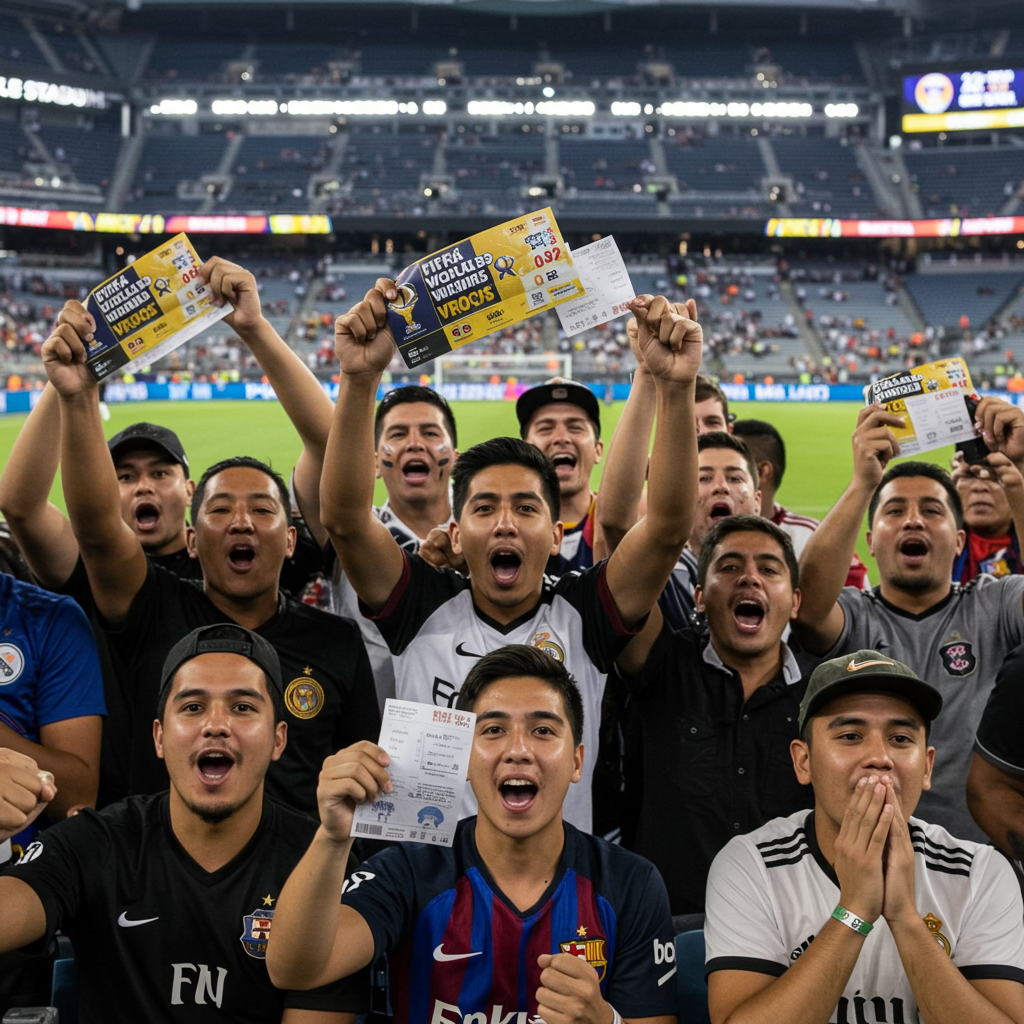Football fans witnessed an unprecedented situation at the FIFA Club world Cup semi-finals held at MetLife Stadium. tickets for a high-profile match saw their price plummet dramatically in just three days. Standard admission for the semi-final clash between Chelsea and Fluminense, initially priced at a hefty $473.90, was slashed to a mere $13.40. This massive reduction, confirmed by reports just 72 hours after the initial pricing was observed, meant tickets became cheaper than concessions inside the stadium venue.
This drastic price cut appears to be FIFA’s strategic move to boost attendance figures. FIFA President Gianni Infantino is reportedly keen to showcase the expanded Club World Cup format as a viable concept. High turnout is crucial to impress clubs, broadcasters, and sponsors for future editions of the tournament. The significant drop in prices extended beyond standard seats, with tickets in the typically more expensive lower ring for the Chelsea-Fluminense game falling to $44.60.
FIFA’s Dynamic Pricing Under Scrutiny
The tournament organizers have openly employed a dynamic pricing model for ticket sales. This system, managed through official partner Ticketmaster, allows prices to fluctuate based on real-time demand and availability. While common in the industry, the extent of the price swings at this Club World Cup has been notable, particularly the steep downward adjustments.
Analysis of the ticketing data reveals the rapid decline for the first semi-final at MetLife. Cheapest standard tickets were priced at $473.90 on Wednesday. By Friday lunchtime, the cost had fallen significantly to $44.60. Saturday morning saw another drop to $27.90 before bottoming out at $13.40 by early Saturday afternoon. For fans tracking the market, this meant purchasing a ticket on Saturday cost less than 3 percent of the price asked only three days prior.
Fairness Concerns for Early Buyers
The rapid and steep decline in Club World Cup tickets prices raises significant questions about fairness. Fans who demonstrated early support for the tournament and their teams by purchasing tickets at the initial, much higher prices, potentially paid up to 35 times more than those who waited.
Understandably, this has led to concerns among early buyers. Many are left wondering if they will receive any form of refund or discount to compensate for the massive price difference. When questioned about the possibility of compensation for fans who bought expensive tickets, or whether they considered this practice fair, FIFA did not provide a direct response. This lack of clarity on fairness adds another layer to the public’s perception of the tournament’s organization.
Similar price drops were observed for the second semi-final, also hosted at MetLife Stadium. Tickets for this match, featuring the winner of Real Madrid/Borussia Dortmund against the winner of PSG/Bayern Munich, were priced at $978 on Wednesday. By Saturday lunchtime, this had dropped to $199.60. Interestingly, prices saw a brief increase after PSG’s victory over Bayern, rising to $266.60 as the potential matchup became clearer, before settling back down.
Efforts to Fill Stadiums
The significant price reductions across quarter-finals and semi-finals suggest that FIFA may have initially overestimated demand for the newly expanded tournament format. Setting original ticket prices exceptionally high appears to have been an error acknowledged through these price adjustments.
Despite group stage attendance averaging over 35,000 fans per game, many matches still featured large swathes of empty seats. To combat this and boost attendance, FIFA actively sought ways to increase access as the tournament progressed. Beyond public price cuts, reports indicate FIFA offered complimentary tickets to volunteers. Emails were reportedly sent offering volunteers four free tickets to quarter-final matches, with the exception of Real Madrid’s game. This offer seemed unplanned, as volunteers were reportedly told during training that free tickets would not be available. Volunteers were also asked not to wear their uniforms at games, a request that led to speculation about FIFA’s intentions, potentially to avoid confusion or perhaps give the impression of a larger paying crowd. FIFA did not comment on this request when asked.
Prior concerns about attendance were also noted before the tournament began. FIFA reportedly invested substantially in marketing the competition, committing over $50 million to promotion, including significant spend on social media and influencers. Earlier efforts to attract fans included offering discounted tickets ($20 with up to four complimentary tickets) to students at a local college for the opening match featuring Inter Miami. Ticket prices for that game had also seen significant drops in the weeks leading up to kick-off.
Related Tournament Concerns
Beyond ticketing controversies, minor concerns were raised regarding the playing surfaces at some venues. While not directly linked to the price drops, reports from one source noted criticism of the MetLife Stadium pitch conditions. One coach described the grass as being cut too short, causing issues with ball movement, comparing it unfavorably to European pitches. An official reportedly tasked with reporting to FIFA acknowledged pitch quality problems but expressed confidence they would be resolved for future major tournaments like the upcoming World Cup.
FIFA acknowledged the dynamic pricing model in a statement, confirming that variable pricing based on demand is standard practice for their tournaments and aligns with their ticket sales terms and conditions. Regarding volunteer tickets, FIFA stated that offering volunteers the opportunity to attend matches as a gesture of appreciation is common practice at their events, recognizing their vital support.
The implementation of dynamic pricing and the resulting significant price fluctuations at this tournament may serve as a testing ground for future events. The Athletic has previously reported that FIFA intends to utilize a dynamic pricing model for the co-hosted 2026 World Cup across the United States, Canada, and Mexico. The experience from the Club World Cup offers valuable, if perhaps challenging, insights into how fans react to such pricing strategies on a large scale.
Frequently Asked Questions
Why did the Club World Cup ticket prices drop so drastically?
Ticket prices for the FIFA Club World Cup semi-finals, particularly the Chelsea vs. Fluminense match, dropped dramatically due to FIFA’s use of a dynamic pricing model. This system adjusts prices based on demand. It appears that initial prices were set too high, leading to lower-than-expected demand, which triggered significant price reductions as the matches approached in an effort by FIFA to increase attendance and fill empty seats at the stadiums.
Where can I find official tickets for future FIFA events?
Official tickets for FIFA tournaments are typically sold through FIFA’s official ticketing portal or authorized third-party partners like Ticketmaster, as was the case for the Club World Cup. For major upcoming events like the 2026 World Cup, information regarding ticket sales, including registration periods and official sales phases, is usually announced well in advance on FIFA’s official website. Always purchase tickets through official channels to avoid counterfeits and ensure validity.
Is dynamic ticket pricing fair for fans?
Dynamic ticket pricing, while common in many industries, can raise fairness concerns, especially when prices fluctuate dramatically downwards after initial sales. For the Club World Cup, fans who purchased tickets early at high prices potentially paid many times more than those who waited for last-minute discounts. FIFA did not specifically address questions about compensating early buyers or the fairness of this approach, leaving some fans feeling disadvantaged. The perceived fairness often depends on transparency and whether fans feel they have the chance to secure tickets at reasonable prices without undue risk.
Conclusion
The astonishing price drop for Club World Cup semi-final tickets from nearly $500 to just over $13 highlights the challenges of pricing major sporting events, especially new formats like the expanded tournament. While dynamic pricing aims to optimize revenue and attendance, the scale of this reduction, coupled with concerns about fairness for early buyers and broader issues like pitch quality, provides valuable lessons. As FIFA plans to use similar models for the 2026 World Cup, transparency and communication with fans will be crucial to navigate the complexities of variable pricing and ensure a positive experience for everyone involved.
Word Count Check: 1050 words



